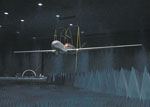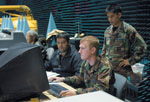Telemetry Revolution Advances
 |
| An RQ-4 Global Hawk Block 20 aircraft hangs inside the Benefield Anechoic Facility, Edwards Air Force Base, California, during electromagnetic profile testing. The integrated Network Enhanced Telemetry (iNET) project is focusing on spectrum-enhancing technologies that will enable the research test and evaluation community to communicate more effectively and efficiently with test vehicles, saving both time and resources. |
The U.S. Defense Department has developed a network architecture that will give its research test and evaluation community new radio spectrum-enhancing capabilities. Once fully operational, the Telemetry Network System will provide its installations’ computer networks with a wideband wireless capability that covers hundreds of square miles. As a result, flight test centers will be able to dynamically adjust the spectrum required for test vehicles. In addition, the technology will enable program managers and aircraft manufacturer personnel to monitor tests from off site.
A result of work that began in October 2004, the Telemetry Network System (TmNS) network architecture is the latest accomplishment in the string of steps that compose the integrated Network-Enhanced Telemetry (iNET) effort. The project’s goal is to find a feasible upgrade for the basic architecture of the test and evaluation ranges’ telemetry systems, an architecture that has not changed in 50 years. Once in place, the iNET would enhance point-to-point telemetry by adding a telemetry network comprising a vehicular network, a wireless network and the existing network infrastructures on Defense Department test and evaluation ranges.
The search for a new approach to telemetry is the military’s response to a growing gap between data collected on test platforms and data transmitted to a test team. While the amount of gathered information has increased, point-to-point telemetry has remained limited in the amount of data that can be transmitted. For example, while flight test instrumentation systems collect more than 200 megabits of data per second, data transmission rates remain at 5 megabits per second. As a result, testers must wait until the craft lands and data is downloaded before they can review information collected during a test.
Under the iNET configuration, time-sensitive data can be transmitted immediately using point-to-point telemetry, while less urgent readings are collected and sent when bandwidth is available or downloaded at a later time. Prioritizing material in this way will free up space on the point-to-point links, decreasing latency.
Prior to undertaking this project, the iNET team conducted a study that revealed which test and evaluation settings would benefit most from a telemetry network. Based on the results, the project has been focusing on the dismounted warfighter, ground vehicles, standard munitions, aeronautical/aircraft and precision-guided munitions/missiles. Development work is being concentrated on the aeronautical environment for Block 1.
While the iNET project currently focuses on testing, the long-term goal is to extend the capability into training and acquisition. The iNET team has been working with the training community already; three Command Test and
Bill Cookson, program manager, iNET, Test Resource Management Center (TRMC),
Cookson uses a test of an F-22 as an example. During flight, telemetry can be lost as the aircraft maneuvers. When this occurs, test directors in control rooms on the ground must immediately decide whether to redo the test because they cannot be sure if the data they need has been collected. Repeating the test takes time, which correlates to additional cost; however, if they wait until the aircraft is on the ground and discover that the data was not captured, the test must then be repeated. In addition, offloading a recorder from an aircraft adds to the testing time, once again increasing the cost of testing, Cookson explains.
“With the iNET capability, what we’re going to be able to do in near-real-time is to acquire those pieces of information that were lost during the maneuver, while the aircraft is setting up for its next test point. That by itself will significantly change the operations in the control room, and I don’t have a very good idea of what that means today yet. We’re still in the process of flushing it out,” he relates.
Although the final impact of the iNET remains unclear, Cookson is confident that the change will be considerable. Today, a test ground crew sets up cards for a particular series of tests. “Now, I’m going to introduce another capability for them to go up and extract additional information off the recorder and display that in the control room. So the mechanics, the protocols, everything else associated with how we conduct business in the control room today is going to change significantly with the introduction of iNET,” he states. As a result, one of the iNET program’s biggest challenges will be change management as new technologies replace the old, he adds.
 |
| Testers observe the antenna performance on the X-51 Scramjet-Waverider at the Benefield Anechoic Facility. Once the iNET is up and running, ground crews testing aircraft capabilities will be able to communicate with the test vehicle using a two-way link. The X-51, an autonomous aircraft designed to travel at hypersonic speeds, is scheduled for its first flight in August 2009. |
Early on, the iNET team also focused on the importance of creating standards, which benefit both the military and the vendor communities. Standards ensure that testing organizations will have choices when purchasing new products and that vendors know the requirements when designing solutions, Cookson explains.
To develop the standards, the iNET program has established three standards working groups. The communications link working group focuses on the standards for the network topology for bidirectional communication. The test article group discusses the standards for the network components as well as other items onboard the testing platform. The ground-station component standards working group addresses the various elements of the test control facilities.
Cookson relates that the communications link and test article groups each comprise more than 30 participants, at least half of whom are vendors. “They’re not only sitting there listening, but they are actually participating in establishing those standards. I believe in the long run when we get ready to actually build the iNET capability, the vendor community—having been engaged with defining the standards—will already understand and will be able to build it with minimal impact to executing the program,” he notes. “It’s an open architecture, and we want these to be open standards.”
Cookson emphasizes that the iNET project “boldly goes where everybody else has gone before. … In the telemetry side of the house right now we enjoy a lot of data in the serial streaming telemetry paradigm. We enjoy it very quickly and we enjoy it error free. That’s what we’re trying to create here with an iNET capability. We want to be able to bring down a lot of information, we want to bring it down quickly and we want it to be quality of service, virtually error free. And you don’t see that today with a lot of the 802.11 stuff.”
Boeing Phantom Works,
Although the initial plan called for a technology demonstration of the telemetry, the strategy has evolved; Cookson has extended the technology demonstration across the entire iNET project. A limited prototype system of the TmNS is projected to be operational by 2011; initial operational capability will follow the completion of full field-testing of the prototype. The system’s high-power uplink transmissions, which enable dynamic control of spectrum, will be implemented in the 1435 to 1525 megahertz and the 2360 to 2390 megahertz bands.
Cookson notes that the commercial sector can help the iNET project in a number of ways. For example, the network topology the team is reviewing probably will not be the long-term solution. Companies interested in participating in the program may want to explore more efficient and effective topologies.
The group also could use some help in three other crucial areas: spectral efficiency technologies, management automation and dynamic spectrum allocation. Cookson says that, at least for next year’s expenditures, network-based spectral efficiency solutions will be a focus area. In terms of management automation, the iNET team is interested in tools for spectrum, network and policy-based management for a wireless network. “For example, in frequency management: How do we do frequency management today? It’s kind of lock step, manual, very restrictive, and large programs schedule up the entire frequency and lock out all of the smaller programs. What we’re hoping to achieve with iNET or at least in the spectrum and frequency management domain is to have that more automated,” he indicates.
Finally, one of the initial capabilities that the iNET team wants to demonstrate in 2011 is the ability to change frequencies on the fly through the uplink. “In other words, I want to change the transceiver and the transmitter onboard the aircraft. Ideally, in the long term, I want dynamic spectrum allocation, where I have a signal frequency and multiple users, and I can dynamically allocate within that frequency. So if I’ve got five players and they all have 5 megabits per second [data transfer], but two of them are just transitioning to another test area, I can bring them down to just health-and-status information on 2 megabits [per second of data transfer] and then make available all of the rest of the spectrum between the high-use players within that spectrum,” Cookson explains.
Although companies could benefit substantially from the test community’s intent to use the C Band as well as the L and S bands, Cookson notes that many vendors are not willing to invest in solutions in these areas until the Defense Department commits nonrecurring engineering dollars to the plan.
Web Resource




Comments